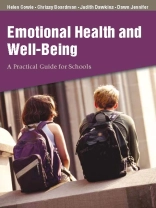`This publication is a valuable and timely contribution to the current investigations into the behaviours of children and young people that impact on their emotional health. The book will serve as a practical guide for schools addressing the problem as they see it, the case studies vividly illustrating situations and behaviours that teachers will readily recognise. This is a well structured book. [It] deserves to be read and can serve as a source of information on how various behaviours have been defined, investigated and addressed. It will be of value to any school, much more than a topical or interesting read but as the basis of an institutional response to a problem seriously affecting educational achievement for individuals and schools. It would particularly serve as a stimulus to in-service training for teachers and support staff′ – George Varnava, Young Minds Magazine
′Each of the authors has considerable relevant expertise so the text is rich both in research data and examples, including case studies, from their experience. Readers will find a wealth of practical advice and encouragement that is balanced by the acknowledgement of the limitations of individual interventions and the potential costs, overt and hidden, of each one. A whole-school approach is advocated and exemplified, including schools that have considered the needs of the staff′ – Child and Adolescent Mental Health
`This work would be of use throughout all age ranges as the different problems and strategies are very easily accessible with a lot of proven, practical support. Professor Cowie and her colleagues have produced a valuable tool for use in all schools on both micro and macro level′ – Education Review
`The book is an impressive and useful handbook of advice and resources. More than that, because it presents so much evidence, it′s able to show, rather than tell, how schools can improve life for their pupils and teachers′ – Gerald Haigh, TES Friday Magazine
` This book is recommended for the wealth of practical information it contains about strategies that can help young people in distress′ – Youth Studies Australia
Secondary school is the place where young people are most constrained, observed and challenged to develop. This is not necessarily a stress free process, either for the young person, or for teachers and parents. This book describes behaviours, both disruptive and secretive, which indicates emotional distress. It looks at both the risk factors and the protective factors involved in emotional health, and addresses the impact of issues such as bullying, social exclusion, loss and bereavement.
The authors show what schools can do to develop practices grounded in knowledge about the mental health issues which relate to young people. In an accessible way, they present a range of strategies which practitioners have shown to be effective. They focus especially on methods and policies, which have been scientifically evaluated, or which are considered best practice.
Issues and interventions are illustrated throughout with case studies drawn from the authors′ own practice and experience. Each of the authors has a long-standing interest in ways of creating supportive environments to prevent distress and to facilitate resilience in the young.
This book is essential reading for secondary school teachers, educational psychologists, education welfare officers and all those with pastoral care responsibilities.
İçerik tablosu
Introduction
The Stigma of Mental Health Difficulties
Why Should Schools be Involved?
Schools in a Social Setting
Why Intervene at Whole School Level?
Where to Start in Matching an Intervention to your School
Creating a School Community
Disaffected Young People
Violent Behaviours
Bullying Behaviours
Sexual Health
Alcohol, Drugs and Substance Abuse
The Socially Isolated/Children in the Autistic/Aspergers Spectrum
Helping Children Deal with Loss
Eating Problems
Deliberate Self Harm
Attention Deficit Hyperactivity Disorder
Accessing Outside Help
Predicting the Difficulties
Review and Evaluation












